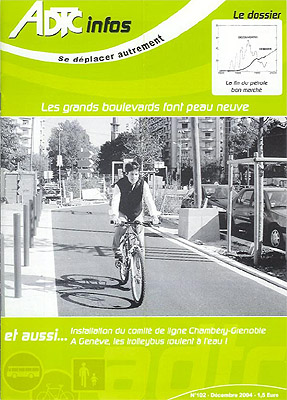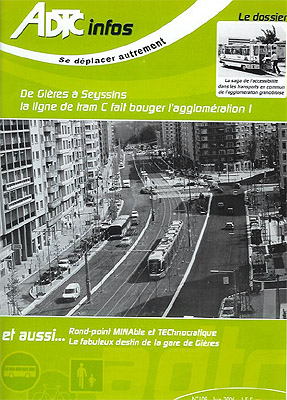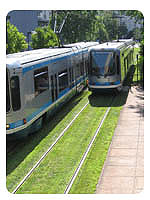Re-balancing our urban transport network is possible, but it takes time and a real political campaign to change people's minds.
By Nicholas Kevlahan
Published May 18, 2007

A streetcar station in downtown Grenoble.
In a recent article for Raise the Hammer, I described the impressive public transport system the city of Grenoble (France) has developed over the last twenty years.
Its centrepiece is a modern streetcar network, but it has also included extensive re-engineering of the streets to make them friendlier to pedestrians and cyclists.
When compared to Hamilton, where transit use has actually declined over those same twenty years, one wonders how they did it.
Was it simply a result of progressive mayors? Did the national government mandate the changes? Has Grenoble always had an excellent public transport system?
I recently returned to Grenoble for a visit, and was lucky to meet the driving force behind many of these changes. It turns out that the change began over 30 years ago, in 1974, when Jean Sivardière helped found the Association pour le Développement des Transports en Commun (ADTC, association for the development of public transport).
Sivardière recalled that in 1973 Grenoble's public transit system had serious problems. Ridership was declining, service was poor and the system was in deficit. Only about eight percent of trips were made using public transit (similar to the figure for Hamilton today).
The mayor at that time was left-leaning and socially progressive, but he still thought of public transit as a social service for the poor who couldn't afford their own car.
Transport planning was based on the automobile: more freeways, road widening and increasing convenience and speed for motorists. Minor improvements to public transit might be considered provided they didn't interfere with motorists. This will sound familiar to residents of Hamilton!
Not surprisingly, Sivardière didn't get far trying to convince the mayor of the need for a profound shift in the Grenoble's transportation thinking.
He realized that it wasn't enough for individuals to write letters to the newspaper, or to try to lobby the mayor and city officials. In order to be taken seriously Sivardière needed numbers: he needed to form a sort of municipal NGO.
Fifteen concerned citizens founded ADTC in 1974, and just one year later they had over a thousant paid-up members! In 1976 ADTC organized a bicycle festival that attracted over six thousand people. City officials were beginning to pay attention.



A selection of some of the ADTC magazine's recent covers.
The first task of the ADTC was to fight for improvements to the bus system. Their strategy was to argue for:
The ADTC also fought against the myth that one can improve public transit (and conditions for cyclists and pedestrians) without interfering with motorists. Driving has to be made less convenient and public transit more convenient before people will switch.
Sivardière emphasized, however, that it is important not to make motorists feel guilty. He himself owns a car and uses it for those trips where public transit is not practical. The goal is to get people to use public transit (or cycle or walk) for regular trips, like commuting and shopping.
Paradoxically, increasing transit use actually makes the occasional car trip easier and more pleasant! By cutting down on car use we reduce pollution, improve physical fitness and reclaim our city streets for people.
Main St in downtown Hamilton is clearly designed for cars only; there is no street life and few businesses. It wasn't always like this, and it doesn't need to be that way in the future.
The simplest way of getting people to take transit is to build a modern streetcar network. The streetcars take space from the cars (putting the city on a "road diet", as recommended by one of the transportation experts at the recent Hamilton Pedestrian Workshop), and are much more comfortable and convenient than buses.
They also have a larger capacity (the current generation can carry 300 passengers each compared with about 75 for a standard bus). Furthermore, streetcar lines are a concrete demonstration of the city's commitment to public transit, and attract new investment wherever they pass.

However, the mayor felt that although streetcars were okay for the orderly Swiss, they would never work in France. He was pushing for the POMA 2000, a futuristic system of small cable driven cars criss-crossing the city high in the air.
Thus began the ADTC's most difficult and most influential campaign. The mayor finally accepted that streetcars were the solution, but then lost power.
The new right-wing mayor was personally in favour of streetcars, but felt his constituency would never support it.
Small business owners in particular were against the plan as they worried that it would reduce parking and vehicle traffic outside their shops. In the end the new mayor decided he would hold a referendum.
The ADTC campaigned hard, countering many anti-streetcar myths, and in the end the yes side won with 52 percent. The first line was built in 1987, and the rest is history.
How did Grenoble finance its public transport revolution? After all, the first objection is always cost. In Grenoble 25 percent comes from fares, 25 percent from the municipality and 50 percent comes from a special transport tax on businesses (one to two percent of employee salaries). In addition, the national government contributed 20 percent of the construction costs of the streetcar system.
It is interesting to note that in Hamilton 55 percent comes from fares and most of the remaining 45 percent comes from property tax. Users here are paying proportionally more than twice as much for an inferior service!
We should also be looking at more creative ways of financing public transit. Money from the gas tax is a step in the right direction, but the federal and provincial governments need to get more involved.
The ADTC continues to be very active (especially on pedestrian and cycling issues), and publishes a glossy monthly magazine for its members on issues related to public transit, cycling and pedestrians. It also distributes press releases, organizes public meetings and demonstrations, responds to the press and conducts research into transport issues.
In 1978 it helped found the Fédération Nationale des Associations d'Usagers des Transports (FNAUT, national federation of transport users) that now represents 150 similar organizations with about 40 000 members in total. Sivardière was president of the ADTC for ten years, and is the current president of the FNAUT.
If there is one message I took away from my meeting with Jean Sivardière, it was this: re-balancing our urban transport network is possible, but it takes time and a real political campaign to change people's minds.
However, if you visit Grenoble I'm sure you'll agree that the results are worth it!
By jason (registered) | Posted May 18, 2007 at 16:50:50
nice finish:
"If there is one message I took away from my meeting with Jean Sivardière, it was this: re-balancing our urban transport network is possible, but it takes time and a real political campaign to change people's minds."
Same was true in Portland. This reason and this reason alone is why I hold out little hope for Hamilton to bring back streetcars and balance our transportation network. 71 Main West.
By beancounter (registered) | Posted May 18, 2007 at 20:54:56
There is hope, Jason.
Gasoline is at $1.10 today. When it goes to $2.10, you are going to see more balance.
Since you're still a young man, you should see it in your lifetime.
Bean Counter
By Nicole (anonymous) | Posted May 23, 2007 at 09:17:55
I think the problem isn't that Hamiltonians don't want to use public transport... But here's why I don't use it on a regular basis:
1. It's more expensive for two people to take the bus round-trip downtown and back than it is to pay for parking in the Core. And that's saying something.
2. I don't commute to work in Hamilton. Like most other twentysomethings in the city, I work along the QEW corridor, and commuting by bus clearly isn't an option. (Though I wish it was.)
3. The HSR, as good as it is, doesn't offer great service to the "new" City of Hamilton. Frankly, it's still a pain to get up the mountain, let alone get to Flamborough, Binbrook, or even to Burlington.
By jason (registered) | Posted May 23, 2007 at 09:55:18
you're right on all 3 counts Nicole. Point number 1 really is sad. Downtown has some of the lowest parking rates of any major city in Canada. GO Transit is a joke and the HSR can't keep up along it's busy east/west lower city corridor let alone start servicing suburban areas better.
Billions are needed to address these problems. And billions are available - just look at all the new road construction in the Golden Horseshoe - hundreds of millions, if not billions, are spent every year. Getting some of that public money directed at transit is the big challenge.
By DredWolf (anonymous) | Posted June 03, 2007 at 17:24:12
Sorry this is a long comment but it is a reflection on my opinion on this subject and urban affairs in general. As a Torontonian who now lives in the former city of Scarborough (but did used to live in Hamilton too), I must say that the problems of transit service funding and deployment are not merely limited to Hamilton. Here in Toronto a single ride is $2.75 and service at times can be best described using unfavourable language. Whether its the TTC's crumbling subway stations (or housing or roads) one cannot help but feel that the future is bleak. All I can say is that if I were confronted by a politican asking how it could be fixed I would say this: tax me! Its very simple people you get what you pay for. It seems that with the emergence of the suburbs and their accumulation to the point where the suburbs and its culture control most of the government's decisions, it suddenly beomes more important to build the red hill creek expressway or 407 or support the auto and oil industry than build an LRT through Hamilton and Toronto's Transit City plan. Because of the influnce of the suburbs, funding is diverted away from our downtowns and redirected to suburban cities like Vaughan with no street life whatsoever and which requires heavy subsidies to service and maintain (the 407/400 interchange in vaughan takes up almost as muach land as that of downtown Toronto). Nowadays you've got Steven Harper and Dalton McGuinty announcing the construction of a subway to Vaughan's corporate centre instead of building a subway along King or Queen St, where both streetcar lines along these streets carry as many or even more passengers than all of GO Transit (I know the GTA is unrelated to Hamilton Wentworth but from what I read and see the conditions doled out by the province and feds are very similar). So here is what we must do, we must stop urban sprawl now! The planet consists of a finite volume and finite resources, a densely built downtown neighborhood like Hess village or Queen St. West in TO is more efficient with energy consumption and land use than Mississauga or upper hamilton (where people are forced to drive everywhere because everything is spread out along eight lane arterials). With an end to urban sprawl we can end the sucking of life out of our downtowns in order to subsidize people's desire to drive an SUV resulting in creating a QEW like Main stret or freeway like conditions as seen at the south end of Spadina Ave. Urban sprawl encroaches on native peopoles land, elects governments like the Harris PCs (whom were elected mostly by suburban communities) and leaves those who choose or have no choice to take the HSR or TTC with expensive fares and poor service. With global wraming and incraesing traffic congestion, it is only a matter of time before Canadians (and Americans) wake up and realize that North America is not a land of unlimited resources where key decisions can be put off. Hamilton's transportatation problems are but one part of a big socio-economic challenge facing the west. Luckily the echo baby boomer generation is reaching a mature age, a generation that is well versed in high-technology and the internet. Even in China the Communist government's propoganda is no match for its people's ability to fight back through the internet. Its only a matter of time before things change, the only question is when?
By Scheinwerfer (registered) | Posted June 07, 2007 at 03:04:31
It's important to balance the carrots and the sticks. It's tempting and popular but insidious to place too much weight on the notion that driving must be made less convenient and/or more costly in order to increase transit usage.
I live in Toronto. A few weeks ago, I dropped off my truck at the alignment shop and hopped on the bus to get to work. Took about the same amount of time as if I'd driven, and I got a nice 5-block walk in the beautiful sunny weather on Toronto's first Smog Alert day. While I walked, I did some mental maths:
The trip from home to work is about 4.6 km.
The truck takes, in round figures, 20 litres per hundred kilometres in slow stop-and-go traffic.
That means each trip to or from work takes about 1 litre of gasoline. One litre of gasoline cost $1.05 on that particular day.
I could walk 3 blocks from home to the subway stop, get on the subway, and wind up across the street from my office. That trip, in either direction, costs me $2.10 if I buy ten tokens or tickets at a time, $2.75 if I pay the fare in cash.
So, my truck would have to get half the lousy mileage it actually gets in order for it to cost as much as the least-costly transit ride. Yikes! Now, of course, this does not factor in the cost of owning the truck, just the cost of driving it. So that compares using the truck vs. not using it, rather than using the truck vs. not having it. So the answer is to jack up the cost of parking, insurance, registration, and other vehicle-ownership factors, and that'll get me to take transit instead, right?
Well...no! What I'm looking for, and what I suspect most people are looking for, is the most cost-effective way to get from A to B. That's not necessarily (nor usually) the same thing as the least-costly way.
Compared to systems like MUNI in San Francisco or the Washington DC Metro, the TTC is grossly inferior. They do a masterful job of making the grossly underfunded system work with what few resources they have—the system generally runs more or less on time, and the stations often don't smell too badly of piss and worse—but the rolling stock (buses, street cars, subway trains) are ancient and increasingly decrepit, the fare has to be unreasonably high because otherwise they couldn't run the system at all, and in general the system only just barely meets Toronto's needs, in only the most basic way. We're still running mostly GMC New Look buses, for heaven's sake, and the last one of those rolled off the assembly line twenty-five years ago! I don't object to old vehicles per se, for constructing new vehicles consumes vast amounts of resources and energy and generates massive waste, but it's a growing struggle for the TTC to keep these (and the even more elderly trains and streetcars) together and rolling every day. There's just no funding for replacements, as it seems.
And it's not just that the TTC's clunkers are repellingly unpleasant to ride, they're also a serious embarrassment in a city that likes to babble about how world-class it is. I was in Frankfurt recently, and was astonished to watch streetcars taking even tight-radius curves with none of the hair-raising squawk and squeal emitted by Toronto's street cars. I was shocked to discover these quiet cars were made by -- guess who? -- Bombardier, right here in Canada.
There's also no money (or perhaps just no will) to implement the kind of farecard system the Washington DC Metro has: Wanna go 2 stops off peak? Cost you 35¢. Wanna go the length of the system at rush hour? Cost you $3.75. Nor does there seem any interest in a timeframe limitless transfer system like TransLink in Vancouver has: Your fare gets you on however many of whichever trains and buses you want to ride within a 90-minute timeframe. After 90 minutes have elapsed, the next ride you want to take or connection you want to make, you pay another fare.
Either the DC-type or the Vancouver-type fare system would probably cause me to quit driving in town altogether; if either were combined with vehicles not hellish to sit in, I'd definitely quit driving in town. Conversely -- pay attention, this is the important part -- punitive measures aimed solely at pushing me out of my vehicle won't get the job done. Tax the roads or the parkades and put the money towards better transit? Yep, I'll go along with that. But tax the roads or the parkades just to punish me for driving? Sorry, that just won't work.
(And please, let's not have any scolding for the cruddy mileage my truck gets. I'm quite aware of it, and have a solution pending as soon as some custom-made engine components are ready. When, in the near future, my situation changes and a truck is no longer required, I will park it for good.)
You must be logged in to comment.
There are no upcoming events right now.
Why not post one?